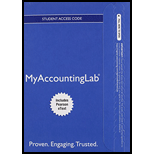
The detailed record of the changes in a particular asset, liability, or owner’s equity is called
Learning Objective 1
a. an account.
b. a journal.
c. a ledger.
d. a
Concept Introduction
Assets: Assets are tangible and intangible resources owned and controlled by a company as a result of past transactions, from which economic benefits are expected to the company. It includes land, machines, cash, etc.
Liability: Liabilities are obligations or payable by the company.
Equity: Equity or capital is the investment of the owner of the company and it is the portion of the total assets that the owner of the business owns.
To find: The name for the detailed record of the changes in a particular asset liability or stockholders' equity.
Answer: An account.
Explanation of Solution
The detailed record of the changes in a particular asset liability or stockholders' equity is called an account.
An account is a chronological record of changes in the value of equity, assets and liabilities, in which every debit and credit transaction gets recorded separately for each asset, liability and equity.
Want to see more full solutions like this?
Chapter 2 Solutions
MyLab Accounting with Pearson eText -- Access Card -- for Horngren's Accounting, The Financial Chapters (My Accounting Lab)
Additional Business Textbook Solutions
MARKETING:REAL PEOPLE,REAL CHOICES
Financial Accounting, Student Value Edition (5th Edition)
Foundations Of Finance
Business Essentials (12th Edition) (What's New in Intro to Business)
FUNDAMENTALS OF CORPORATE FINANCE
Horngren's Financial & Managerial Accounting, The Financial Chapters (Book & Access Card)
- Please provide the correct answer to this general accounting problem using valid calculations.arrow_forwardPlease provide the correct answer to this general accounting problem using valid calculations.arrow_forwardCan you solve this general accounting problem using appropriate accounting principles?arrow_forward
 Accounting Information SystemsAccountingISBN:9781337619202Author:Hall, James A.Publisher:Cengage Learning,
Accounting Information SystemsAccountingISBN:9781337619202Author:Hall, James A.Publisher:Cengage Learning, Auditing: A Risk Based-Approach (MindTap Course L...AccountingISBN:9781337619455Author:Karla M Johnstone, Audrey A. Gramling, Larry E. RittenbergPublisher:Cengage Learning
Auditing: A Risk Based-Approach (MindTap Course L...AccountingISBN:9781337619455Author:Karla M Johnstone, Audrey A. Gramling, Larry E. RittenbergPublisher:Cengage Learning Intermediate Accounting: Reporting And AnalysisAccountingISBN:9781337788281Author:James M. Wahlen, Jefferson P. Jones, Donald PagachPublisher:Cengage Learning
Intermediate Accounting: Reporting And AnalysisAccountingISBN:9781337788281Author:James M. Wahlen, Jefferson P. Jones, Donald PagachPublisher:Cengage Learning- Principles of Accounting Volume 1AccountingISBN:9781947172685Author:OpenStaxPublisher:OpenStax College
 College Accounting (Book Only): A Career ApproachAccountingISBN:9781337280570Author:Scott, Cathy J.Publisher:South-Western College Pub
College Accounting (Book Only): A Career ApproachAccountingISBN:9781337280570Author:Scott, Cathy J.Publisher:South-Western College Pub





